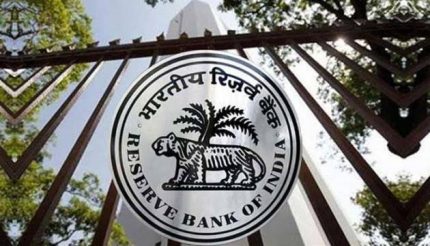Yields on Treasury Bills fell sharply on August 3, indicating that concerns of an aggressive rate hike by the Reserve Bank of India have eased, bankers and money market participants said.
Treasury Bills, or T-Bills, are short-term debt instruments issued by the government. They are presently issued in three tenors — 91 days, 182 days and 364 days.
T-Bill auctions typically take place every Wednesday. Short-term money market instruments, including T-Bills, are very sensitive to the liquidity position in the banking system and rate hikes by the central bank.
At the auction on August 3, the RBI sold 91-day T-Bills at a cut-off yield of 5.56 percent, down six basis points (bps) from last week. It sold the 182-day and 364-day notes at 5.89 percent and 6.23 percent cut-off yields, respectively, down nine and 10 bps from last week’s levels. One basis point is one-hundredth of a percentage point.
“Some of the pressure on liquidity has eased, hence short-term rates have eased. In addition, softer crude prices and easing of pressure on the rupee would also lead to a relief on liquidity and hence T-bill yields have eased,” said Aditya Vyas, economist – fixed Income and macroeconomic research, STCI Primary Dealer. “With 90 bps of rate hikes done so far, it is natural for the market to expect some moderation in the pace of rate hikes going ahead.”
RBI’s rate-setting Monetary Policy Committee (MPC) has hiked the policy repo rate, at which it lends short-term money to commercial banks, twice, by 40 bps and 50 bps, since May in an attempt to douse inflation. The next policy announcement is due on August 5.
Also read: Moneycontrol Poll | MPC set to hike repo rate by at least 35 bps this week
Why has the liquidity surplus increased?
According to central bank data, net liquidity absorbed by the RBI as on August 3 was just above Rs 2 lakh crore, up from Rs 49,245 crore on a week ago. This indicates that surplus liquidity has risen sharply between the last two T-Bill auctions.
The RBI, which is looking to scale back pandemic-era surplus, has ensured that liquidity will continue to be in surplus at least this year. Although RBI will continue to suck out liquidity surplus, the process is unlikely to be hurried, said bankers.
“Typically, during the first few days of every month, government spending is high, which is why the liquidity surplus has improved,” said a treasury official with a state-run bank, requesting anonymity.
The banker was referring to government payments towards salaries, pensions and subsidies that are made at the end and the first few days of every month.
“Banks are deploying surplus liquidity in short-term instruments like T-Bills and commercial paper at higher yields, rather than keeping the funds idle and/or parking them in Standing Deposit Facility (SDF),” the banker said.
The SDF is a collateral-free deposit facility that allows RBI to absorb liquidity from the banking system without having to give government securities as collateral to banks. The SDF rate is currently 4.65 percent.
Apart from that, the rupee has appreciated over the past few days against the dollar. On August 3, the rupee closed at 79.16 to the dollar, up 0.9 percent from 79.90 last week. According to money market participants, the RBI was less active this week in selling dollars to ease volatility in the rupee’s exchange rate. When RBI sells dollars, it drains excess rupee liquidity.
“The strengthening of the rupee in the last week has been a reason for reduction in the short-term yields, given that a weak currency reflects a potential for large imported inflation,” said Vivek Iyer, partner and leader – financial services risk, Grant Thornton Bharat.
No aggressive rate hikes seen
According to economists, the MPC is expected to signal on Friday that inflation may have peaked. This has given rise to expectations that the RBI may not be as aggressive as earlier speculated in raising rates in the upcoming policy announcement, increasing demand for T-Bills.
Prior to June’s inflation print, T-Bill rates had priced in aggressive rate hikes by the MPC.
India’s headline retail inflation rate, measured by the Consumer Price Index, was largely unchanged at 7.01 percent in June from 7.04 percent in May. CPI inflation averaged 7.3 percent in April-June, 20 bps lower than the RBI’s forecast.
According to BofA Securities, there is a “high chance” inflation could undershoot the RBI’s current forecast of 7.4 percent for July-September too.
“Because of sharp rate hikes in the immediate past globally as well as on the domestic front, there is expectation that growth will suffer and lead to recession,” said Marzban Irani, chief investment officer – fixed income, LIC Mutual Fund Asset Management. “As a result, the rate hikes will be slow going ahead.”
Irani expects the MPC to hike the repo rate by 50 bps on Friday. However, a certain section of the market is expecting a lower rate hike of 25 to 35 basis points, he said. The terminal rate should be in the range of 5.50 percent to 6 percent, Irani added. The rate stands at 4.90 percent now.
Volatility to persist
Experts said volatility in T-Bill rates is likely to persist and determining a clear trend could be difficult at this stage. T-bill yields are largely a function of liquidity and the overall interest rate outlook of the market, along with the extent of supply.
“The short-term instruments will continue to be volatile and its yields will steadily increase if there is a large supply of T-bills, commercial paper and certificates of deposits in the fiscal second half. This is even though some portion of future repo hikes is already priced in,” said Venkatakrishnan Srinivasan, founder and managing partner at Rockfort Fincap, a Mumbai-based debt advisory firm.
“When credit growth is rising, system liquidity will continue to remain as one of the main drivers for yield volatility,” Srinivasan said. “Banks will be investing in T-bills mainly for trading purposes and when they have excessive liquidity.”
LIC Mutual Fund Asset Management’s Irani had similar views.
“Whether T-Bill yields have peaked or not will depend on supply in second half. If any additional borrowing is announced, that may put additional burden on yields,” added Irani.





































